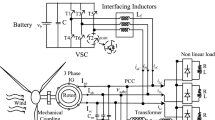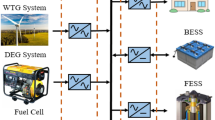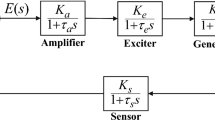Abstract
A considerable no. of intermittent renewable sources such as PV generation and wind energy when integrated to the conventional grid technology causes serious issues in the power systems like frequency instability. So a more balancing controller is desired for a stable and reliable operation of the power system. Bidirectional power control of the EV aggregator is making itself a wise choice for distributed energy storage to scale down the frequency and power fluctuation. In this work, an intelligent load frequency controller using a fractional-order adaptive fuzzy PID controller with filter (FOAFPIDF) for hybrid power system with electric vehicle (EV) based on modified salp swarm algorithm (MSSA) technique is proposed. The effectiveness of MSSA technique is compared with original salp swarm algorithm as well as moth flame optimization , grey wolf optimization , particle swarm optimization and sine cosine algorithm techniques for benchmark test functions using statistical analysis. The effectiveness of the suggested load frequency control strategy by the use of electric vehicle as well as with other energy storing elements such as the superconducting magnetic energy storage component, flywheel energy storage system and ultra-capacitor along with their inherent rate constraint nonlinearity is validated by numerical simulations conducted on the studied test system. It is demonstrated that the proposed controller provides a better control action to suppress the frequency fluctuations as compared to PID controller. The robustness of the controller is also investigated against variation of system parameters and random load changes.

















Similar content being viewed by others
Abbreviations
- n :
-
No. of variables
- F :
-
Food source
- l :
-
Current iteration
- L :
-
Maximum no. of iteration
- K PV :
-
Gain of photovoltaic system
- T PV :
-
Time constant of photovoltaic system
- K WTG :
-
Gain of WTG
- T WTG :
-
Time constant of WTG
- K AE :
-
Gain of aqua electrolyser
- T AE :
-
Time constant of aqua electrolyser
- K FC :
-
Gain of FC
- T FC :
-
Time constant of FC
- K DEG :
-
Gain of DEG
- T DEG :
-
Time constant of DEG
- K FESS :
-
Gain of FESS
- T FESS :
-
Time constant of FESS
- K UC :
-
Gain of ultra-capacitor
- T UC :
-
Time constant of ultra-capacitor
- \(K_{SMES}\) :
-
Gain of BESS
- \(K_{SMES}\) :
-
Time constant of BESS
- \(K_{EV}\) :
-
Gain of EV
- \(T_{EV}\) :
-
Time constant of EV
- V W :
-
Wind speed
- \(\varphi\) :
-
Solar radiation
- D :
-
Damping constant
- M :
-
Inertia constant
- ∆f :
-
Frequency deviation
- u :
-
Control signal
- P PV :
-
Photovoltaic power output
- P WTG :
-
Wind turbine generator output
- P L :
-
Load demand
- P FESS :
-
FESS power output
- P SMES :
-
SMES power output
- P EV :
-
Electric vehicle power output
- P UC :
-
Ultra-capacitor power output
- PU:
-
Per unit
References
Agrawal, B. L., Anderson, P. M., Concordia, C., Farmer, R. G., Fouad, A. A., Kundur, P., et al. (1999). Damping representation for power system stability studies. IEEE Transactions on Power Systems., 14(1), 151–157.
Ali, E. S., & Abd-Elazim, S. M. (2011). Bacteria foraging optimization algorithm based load frequency controller for interconnected power system. International Journal of Electrical Power & Energy Systems, 33(3), 633–638.
Ali, R., Mohamed, T. H., Qudaih, Y. S., & Mitani, Y. (2014). A new load frequency control approach in an isolated small power systems using coefficient diagram method. International Journal of Electrical Power & Energy Systems., 56, 110–116.
Alomoush, M. I. (2010). Load frequency control and automatic generation control using fractional-order controllers. Electrical Engineering.,, 91(7), 357–368.
Chaturvedi, K. T., Pandit, M., & Srivastava, L. (2009). Particle swarm optimization with time varying acceleration coefficients for non-convex economic power dispatch. International Journal of Electrical Power & Energy Systems, 31(6), 249–257.
Cuevas, E., Echavarria, A., & Ramirez-Ortegon, M. A. (2014). An optimization algorithm inspired by the states of matter that improves the balance between exploration and exploitation. Applied Intelligence, 40(2), 256–272.
Datta, M., & Senjyu, T. (2013). Fuzzy control of distributed PV inverters/energy storage systems/electric vehicles for frequency regulation in a large power system. IEEE Transactions on Smart Grid., 4(1), 479–488.
Debbarma, S., & Dutta, A. (2016a). Utilizing electric vehicles for LFC in restructured power systems using fractional order controller. IEEE Transactions on Smart Grid., 8(6), 1–11.
Debbarma, S., & Dutta, A. (2016b). Utilizing electric vehicles for LFC in restructured power systems using fractional order controller. IEEE Transactions on Smart Grid., 8(6), 2554–2564.
Fereidouni, A., Masoum, M. A., & Moghbel, M. (2015). A new adaptive configuration of PID type fuzzy logic controller. ISA Transactions., 56, 222–240.
Kennel, F., Gorges, D., & Liu, S. (2013). Energy management for smart grids with electric vehicles based on hierarchical MPC. IEEE Transactions on Industrial Informatics, 9(3), 1528–1537.
Ko, K. S., & Sung, D. K. (2017). The effect of EV aggregators with time-varying delays on the stability of a load frequency control system. IEEE Transactions on Power Systems., 33(1), 1–12.
Lee, D. J., & Wang, L. (2008). Small-signal stability analysis of an autonomous hybrid renewable energy power generation/energy storage system part-I: Time-domain simulations. IEEE Transactions on Energy Conversion, 23(1), 311–320.
Mamdani, E. H. (1974). Applications of fuzzy algorithms for simple dynamic plant. Proceedings of the Institution of Electrical Engineers.,, 121(12), 1585–1588.
Masuta, T., & Yokoyama, A. (2012). Supplementary load frequency control by use of a number of both electric vehicles and heat pump water heaters. IEEE Transactions on Smart Grid., 3(3), 1253–1262.
Mirjalili, S. (2015). Moth-flame optimization algorithm: A novel nature-inspired heuristic paradigm. Knowledge-Based Systems., 89, 228–249.
Mirjalili, S. (2016). SCA: A sine cosine algorithm for solving optimization problems. Knowledge-Based Systems., 96, 120–133.
Mirjalili, S., Gandomi, H., Mirjalili, S., Saremi, S., Faris, H., & Mirjalili, S. M. (2017). Salp swarm algorithm: A bio-inspired optimizer for engineering design problems. Advances in Engineering Software.,, 114, 163–191.
Mirjalili, S., Mirjalili, S. M., & Lewis, A. (2014). Grey wolf optimizer. Advances in Engineering Software., 69, 46–61.
Padhy, S., Panda, S., & Mahapatra, S. (2017). A modified GWO technique based cascade PI-PD controller for AGC of power systems in presence of plug in electric vehicles. Engineering Science and Technology, an International Journal, 20(2), 427–442.
Pahasa, J., & Ngamroo, I. (2015). PHEVs bidirectional charging/discharging and SoC control for microgrid frequency stabilization using multiple MPC. IEEE Transactions on Smart Grid., 6(2), 526–533.
Pan, I., & Das, S. (2015). Kriging based surrogate modeling for fractional order control of microgrids. IEEE Transactions on Smart Grid., 6(1), 36–44.
Pan, I., & Das, S. (2016a). Fractional order AGC for distributed energy resources using robust optimization. IEEE Transactions on Smart Grid., 7(5), 2175–2186.
Pan, I., & Das, S. (2016b). Fractional order fuzzy control of hybrid power system with renewable generation using chaotic PSO. ISA Transactions, 62, 19–29.
Panda, S., Mohanty, B., & Hota, P. K. (2013). Hybrid BFOA–PSO algorithm for automatic generation control of linear and nonlinear interconnected power systems. Applied Soft Computing., 13(12), 4718–4730.
Panda, S., & Yegireddy, N. K. (2013). Automatic generation control of multi-area power system using multi-objective non-dominated sorting genetic algorithm-II. International Journal of Electrical Power & Energy Systems., 53, 54–63.
Pham, T. N., Nahavandi, S., Hien, L. V., Trinh, H., & Wong, K. P. (2017). Static output feedback frequency stabilization of time-delay power systems with coordinated electric vehicles state of charge control. IEEE Trans on Power Systems., 32(5), 3862–3874.
Pothiya, S., & Issarachai, N. (2008). Optimal fuzzy logic-based PID controller for load–frequency control including superconducting magnetic energy storage units. Energy Conversion and Manage, 49(10), 2833–2838.
Ranganayakulu, R., Babu, G. U., Rao, A. S., & Patle, D. S. (2016). A comparative study of recent fractional order PIλ/PIλDµ tuning rules for stable first order plus time delay processes. Separation Technologies in Chemical, Biochemical, Petroleum and Environmental Engineering., 15, 136–152.
Ray, P., Mohanty, S., & Kishor, N. (2010). Small-signal analysis of autonomous hybrid distributed generation systems in presence of Ultra capacitor and tie-line operation. Journal of Electrical Engineering., 61(4), 205–214.
Ray, P. K., Mohanty, S. R., & Kishor, N. (2011). Proportional–integral controller based small-signal analysis of hybrid distributed generation systems. Energy Conversion and Management, 52(4), 1943–1954.
Sahu, R. K., Panda, S., & Sekhar, G. C. (2015). A novel hybrid PSO-PS optimized fuzzy PI controller for AGC in multi area interconnected power systems. International Journal of Electrical Power & Energy Systems., 64, 880–893.
Savran, A., & Kahraman, G. (2014). A fuzzy model based adaptive PID controller design for nonlinear and uncertain processes. ISA Transactions., 53(2), 280–288.
Senjyu, T., Nakaji, T., Uezato, K., & Funabashi, T. (2005). A hybrid power system using alternative energy facilities in isolated island. IEEE Transactions on Energy Conversion., 20(2), 406–414.
Taher, S. A., Fini, M. H., & Aliabadi, S. F. (2014). Fractional order PID controller design for LFC in electric power systems using imperialist competitive algorithm. Ain Shams Engineering Journal.,, 5(1), 121–135.
Vachirasricirikul, S., & Ngamroo, I. (2014). Robust LFC in a smart grid with wind power penetration by coordinated V2G control and frequency controller. IEEE Transactions on Smart Grid, 5(1), 371–380.
Woo, Z. W., Chung, H. Y., & Lin, J. J. (2000). A PID type fuzzy controller with self-tuning scaling factors. Fuzzy Sets and Systems, 115(2), 321–326.
Yao, X., Liu, Y., & Lin, G. (1999). Evolutionary programming made faster. IEEE Transactions on Evolutionary Computation., 3(2), 82–102.
Zhang, J., & Xu, H. (2017). Online identification of power system equivalent inertia constant. IEEE Transactions on Industrial Electronics., 64(10), 8098–8107.
Author information
Authors and Affiliations
Corresponding author
Additional information
Publisher's Note
Springer Nature remains neutral with regard to jurisdictional claims in published maps and institutional affiliations.
Rights and permissions
About this article
Cite this article
Mohanty, D., Panda, S. Modified Salp Swarm Algorithm-Optimized Fractional-Order Adaptive Fuzzy PID Controller for Frequency Regulation of Hybrid Power System with Electric Vehicle. J Control Autom Electr Syst 32, 416–438 (2021). https://doi.org/10.1007/s40313-020-00683-9
Received:
Revised:
Accepted:
Published:
Issue Date:
DOI: https://doi.org/10.1007/s40313-020-00683-9




